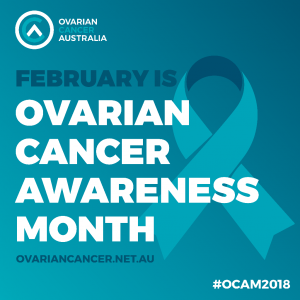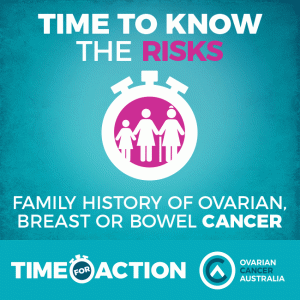Ovarian cancer
What every woman needs to know
Every year over 4,500 Australian women are diagnosed with a form of gynological cancer – uterine, ovarian, cervical, vulval and vaginal cancer. For women who are diagnosed with ovarian cancer the survival rate five years after diagnosis is 43%, the highest mortality rate for all gynological cancers.
The four signs and symptoms most commonly associated with ovarian cancer are:
- Increased abdominal size or persistent abdominal bloating
- Abdominal or pelvic pain
- Feeling full after eating a small amount of food
- Needing to urinate more often or urgently
Additional signs and symptoms include:
- Changes in bowel habits
- Unexplained weight gain or loss
- Excessive fatigue
- Low back pain
- Indigestion or nausea
Finally if you experience either of the following symptoms you should make an appointment to see your doctor:
- Bleeding in-between menstruation or after menopause
- Pain during sex or bleeding afterwards



Know your risk

Risk factors that increase your risk for developing ovarian cancer include:
- Increased age, particularly over 50 years of age
- Family history of ovarian, breast or bowel cancer
- Genetic mutations in BRCA1 or BRCA2 genes
- Women of Ashkenazi Jewish descent
- Endometriosis diagnosis
- Previous diagnosis of breast or bowel cancer
- Diabetes diagnosis
- Hormone replacement therapy
- Smoking
- Never having children or having children later in life
- Physical inactivity and obesity
There are a handful of ways you can reducing your risk of developing ovarian cancer include:
- Using the oral contraceptive pill
- Surgical removal of your ovaries and fallopian tubes
- Physical activity for more than 2hrs/wk (*Further research needed)
Medical interventions including surgery, chemotherapy, radiation, hormonal therapy and targeted therapies can result in long term changes to a person’s body. These can changes can occur both during and after treatment, with some changes permanently altering your body or continuing years after treatment has been completed. These can include:
- Fatigue
- Pain
- Cardiovascular damage or increased risk of cardiovascular disease
- Respiratory or pulmonary changes
- Neurological changes (nerve damage and cognitive changes)
- Psychological changes (increased risk of depression, anxiety, PTSD type symptoms)
- Endocrine changes (reproductive changes – infertility, early menopause, impaired sexual function; increased body weight)
- Musculoskeletal changes (decreased muscle mass; decreases to bone health)
- Immune system (impaired immune function; anemia; lymphedema)
- Gastrointestinal system changes or impaired function
- Organ function changes
According to American College of Sports Medicine “…exercise plays a vital role in cancer prevention and control.” Exercise decreases the risk of developing many cancers and may extend life expectancy cancer survivors. The most recent guidelines state that individuals who are battling cancer are recommended to engage in physical activity for 150 mins/week at a moderate intensity. However, if an individual with cancer is unable to meet these recommendations than they should be as physically active as their ability and condition allows.
Furthermore there is an explicit recommendation that individuals battling cancer are to avoid physical inactivity. Physical inactivity throughout your life can increase your risk of being diagnosed with ovarian cancer by 34% according to one study. Additionally, inactive women who are diagnosed with ovarian cancer increase their risk of mortality by 22%-34%.
The most current research reports that women with ovarian cancer who meet the physical activity guidelines of 150 mins/week of moderate intensity self-report to have better sleep, less cancer related fatigue, improved psychosocial functioning and improved health related quality of life. Additionally one study has found that exercise improved cardiorespiratory fitness and health related quality of life over a 6 month period for women who were undergoing treatment for ovarian cancer.
If you would like to reduce your risk of developing cancer the exercise physiologist at Melbourne Osteohealth can help you to develop an exercise routine that fits in with your lifestyle. We offer tailored exercise programs that can be delivered in individual sessions, small group exercise classes or that you can undertake at home.
References:
- Ovarian Cancer Australia © https://ovariancancer.net.au/
- Schmitz, K. H., Courneya, K. S., Matthews, C., Denmark-Wahnefried, W., Galvao, D. A., Pinto, B. M., Irwin, M. L., Wolin, K. Y., Segal, R. J., Lucia, A., Schneider, C. M., von Gruenigen, V. E., Schwartz, A. L. (2010) American College of Sports Medicine roundtable on exercise guidelines for cancer survivors. Medicine and Scinece in Sports and Exercise. 42(7) 1409-1426. DOI:10.1249/MSS.0b013e3181e0c112
- Exercise is Medicine Australia. (2014) Gynaecological cancer and exercise factsheet. http://exerciseismedicine.com.au/wp-content/uploads/2016/11/2014-Gynaecological-Cancer-FULL.pdf
- Zhou, Y., Catmel, B., Gottlieb, L., Ercolano, E.A., Li, F., Harrigan, M., McCorkle, R., Liqibel, J. A., von Gruenigen, V. E., Gogoi, R., Schwartz, P. E., Risch, H. A., Irwin, M. L. (2017) Randomized trial of exercise on quality of life in women with ovarian cancer: Women’s activity and lifestyle study in Connecticut (WALC). Journal of National Cancer Institute. 109(12) doi: 10.1093/jnci/djx072.
- Moonsammy, S. H., Guglietti, C. L., Mina, D. S., Ferguson, S., Kuk, J. L., Urowitz, S., Wiljer, D., Ritvo, P. (2013) A pilot study of an exercise and cognitive behavioural therapy intervention for epithelial ovarian cancer patients. Journal of Ovarian Research. 6(21) org/10.1186/1757-2215-6-21
- Moorman, P. G., Jones, L. W., Akushevich, L., Schildkraut, J. M. (2011) Recreational Physical Activity and ovarian cancer risk and survival. Annals of Epidemiology. 21(3):178-187. doi:10.1016/j.annepidem.2010.10.014
- Cannioto, R. A., LaMonte, M. J., Kelemen, L. E. et al. (2016) Recreational physical inactivity and mortality in women with invasive epithelial ovarian cancer: Evidence from the Ovarian Cancer Association Consortium. British Journal of Cancer 115(1): 95-101. doi: 10.1038/bjc.2016.153
- Cannioto, R., LaMonte, M. J., Risch, H. A. et al. (2016) Chronic recreational physical inactivity and epithelial ovarian cancer risk: Evidence from the Ovarian Cancer Association Consortium. Cancer Epidemiology, Biomarkers and Prevention. 25(7): 1114-1124. DOI:1158/1055-9965.EPI-15-1330



